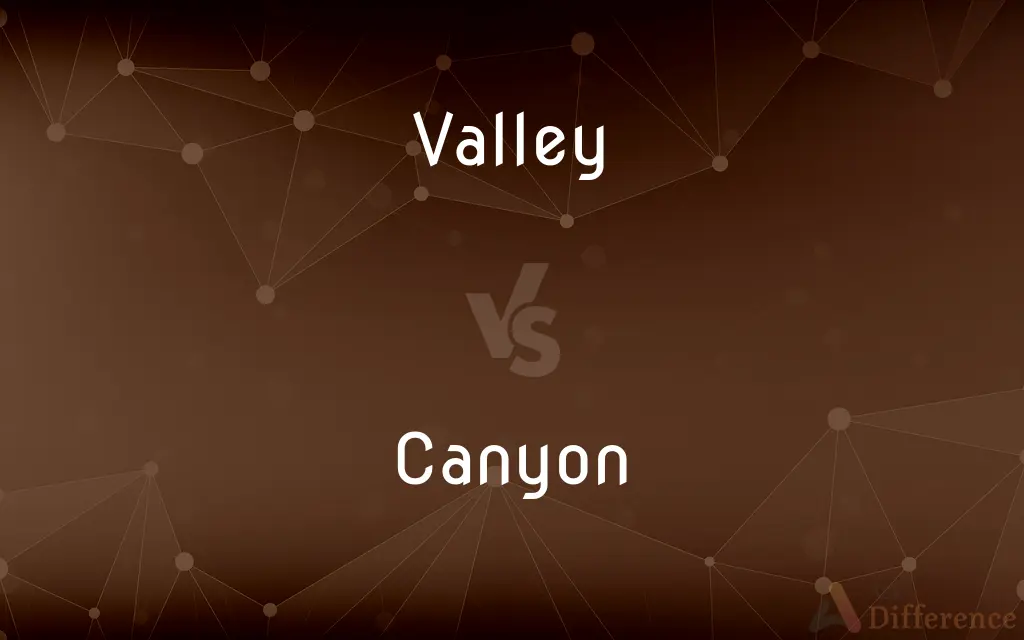Valley vs. Canyon — What's the Difference?
By Tayyaba Rehman — Updated on July 11, 2024
A valley is a low area between hills or mountains, often with a river flowing through it, while a canyon is a deep, narrow chasm with steep cliff walls, usually carved out by a river.

Difference Between Valley and Canyon
Table of Contents
ADVERTISEMENT
Key Differences
A valley is characterized by its elongated depression between uplands, hills, or mountains. Typically, valleys are vast and can span long distances. A canyon, on the other hand, is a type of valley but is deeper and has more vertical sides, making it appear narrower.
The formation of a valley can be due to glacial movements, erosion, or tectonic plate movements. Often, they host rivers or streams. Conversely, a canyon is generally the result of erosion caused by rivers over long periods, cutting deep into a plateau or mountain range.
When you think of a valley, it evokes images of wide, expansive landscapes, possibly agricultural fields, and often a sense of serenity. In contrast, a canyon brings forth visions of dramatic drops, rocky formations, and a river furiously carving its path at the bottom.
Valleys can be found across the globe, from the vast plains in Africa to the green dales in England. They are versatile in terms of climate and usage. Canyons, with their steep sides, are less habitable, but their sheer beauty makes them popular tourist destinations.
Both valleys and canyons play crucial roles in shaping the Earth's topography. While valleys often serve as pathways for rivers and provide fertile land for agriculture, canyons are stark reminders of nature's power and the passage of time.
ADVERTISEMENT
Comparison Chart
Definition
A low area between hills or mountains
A deep, narrow chasm with steep sides
Formation
Erosion, glaciation, or tectonic activity
Primarily river erosion
Appearance
Wide and expansive
Deep, narrow, and often with vertical walls
Usage
Agriculture, habitation, and transportation
Tourism, limited habitation
Examples
The Indus Valley, the San Fernando Valley
The Grand Canyon, Bryce Canyon
Compare with Definitions
Valley
A trough between two ridges on a roof or other surface.
The valley of the roof was collecting rainwater.
Canyon
A deep gorge with cliffs, carved by a river.
The canyon echoed with the calls of distant birds.
Valley
A region drained by a river and its tributaries.
The Mississippi River valley is incredibly fertile.
Canyon
A narrow chasm with steep cliff walls.
The hikers descended into the canyon cautiously.
Valley
An elongated lowland between ranges of mountains, hills, or other uplands.
The picturesque valley was surrounded by snow-capped peaks.
Canyon
A ravine formed by weathering and water erosion.
The river ran fiercely at the bottom of the canyon.
Valley
A depression or hollow resembling or suggesting a valley, as the point at which something divides.
The valley in the folded paper made the perfect crease.
Canyon
A deep valley with very steep sides of rock that usually has a river running through it.
They took a rafting trip through the canyon's rapids.
Valley
A valley is an elongated low area often running between hills or mountains, which will typically contain a river or stream running from one end to the other. Most valleys are formed by erosion of the land surface by rivers or streams over a very long period of time.
Canyon
A dramatic geological formation resulting from erosion.
The canyon stood as a testament to nature's power and time.
Valley
A low area of land between hills or mountains, typically with a river or stream flowing through it
The valley floor
The Thames Valley
Canyon
A canyon (from Spanish: cañón; archaic British English spelling: cañon) or gorge is a deep cleft between escarpments or cliffs resulting from weathering and the erosive activity of a river over geologic time scales. Rivers have a natural tendency to cut through underlying surfaces, eventually wearing away rock layers as sediments are removed downstream.
Valley
An internal angle formed by the intersecting planes of a roof, or by the slope of a roof and a wall.
Canyon
A deep gorge, typically one with a river flowing through it, as found in North America
The Grand Canyon
Valley
An elongated lowland between ranges of mountains, hills, or other uplands, often having a river or stream running along the bottom.
Canyon
A narrow chasm with steep cliff walls, cut into the earth by running water; a gorge.
Valley
An extensive area of land drained or irrigated by a river system.
Canyon
A valley, especially a long, narrow, steep valley, cut in rock by a river.
Valley
A depression or hollow resembling or suggesting a valley, as the point at which the two slopes of a roof meet.
Canyon
The English form of the Spanish word Cañon.
Valley
An elongated depression cast between hills or mountains, often garnished with a river flowing through it.
Canyon
A ravine formed by a river in an area with little rainfall
Valley
An area which drains itself into a river.
Valley
Any structure resembling one, e.g. the interior angle formed by the intersection of two sloping roof planes.
Valley
To form the shape of a valley.
Valley
The space inclosed between ranges of hills or mountains; the strip of land at the bottom of the depressions intersecting a country, including usually the bed of a stream, with frequently broad alluvial plains on one or both sides of the stream. Also used figuratively.
The valley of the shadow of death.
Sweet interchangeOf hill and valley, rivers, woods, and plains.
Valley
The place of meeting of two slopes of a roof, which have their plates running in different directions, and form on the plan a reëntrant angle.
Valley
A long depression in the surface of the land that usually contains a river
Valley
A low area of land between hills or mountains.
The valley was covered in a blanket of wildflowers.
Common Curiosities
Are all canyons valleys?
Yes, all canyons are a type of valley, but not all valleys are canyons.
Can people live in canyons?
While valleys are more habitable and versatile, people do live in some canyons, though it's less common.
What's the main difference between a valley and a canyon?
A valley is a broad lowland, while a canyon is a deep, narrow chasm with steep sides.
How is a valley formed?
Valleys can form from erosion, glaciation, or tectonic movements, unlike canyons which mainly form from river erosion.
Can you farm in a canyon?
Farming in a canyon can be challenging due to steep walls, but valleys often offer fertile land suitable for agriculture.
Why are canyons popular tourist spots?
Canyons offer dramatic landscapes and unique geological features, unlike the serene beauty of many valleys.
Which is larger, a valley or a canyon?
Typically, a valley is larger and more expansive, while a canyon is deeper and narrower.
Which is better for hiking, a valley or a canyon?
Both offer unique hiking experiences; valleys might be more open, while canyons provide dramatic views and challenges.
Which is a famous canyon?
The Grand Canyon in Arizona is world-famous, whereas there are many famous valleys worldwide.
Do valleys always have rivers?
Not always, but many valleys have rivers or streams, just as many canyons are carved by rivers.
How deep can canyons get?
Canyons can be thousands of feet deep, with the depth varying greatly, unlike valleys which are typically not as deep.
Are valleys always green and fertile?
No, while many valleys are fertile, some can be arid or rocky, just as canyons vary in their environments.
Can a valley turn into a canyon?
Over time, with significant river erosion, parts of a valley could deepen and resemble a canyon.
Are canyons found worldwide?
Yes, just as valleys are found across the world, canyons too are spread across different continents and environments.
Do rivers in canyons have rapid currents?
Often, rivers in canyons have rapids due to the steep gradient, while rivers in valleys may flow more gently.
Share Your Discovery

Previous Comparison
Listening vs. Speaking
Next Comparison
Ought vs. AughtAuthor Spotlight
Written by
Tayyaba RehmanTayyaba Rehman is a distinguished writer, currently serving as a primary contributor to askdifference.com. As a researcher in semantics and etymology, Tayyaba's passion for the complexity of languages and their distinctions has found a perfect home on the platform. Tayyaba delves into the intricacies of language, distinguishing between commonly confused words and phrases, thereby providing clarity for readers worldwide.













































